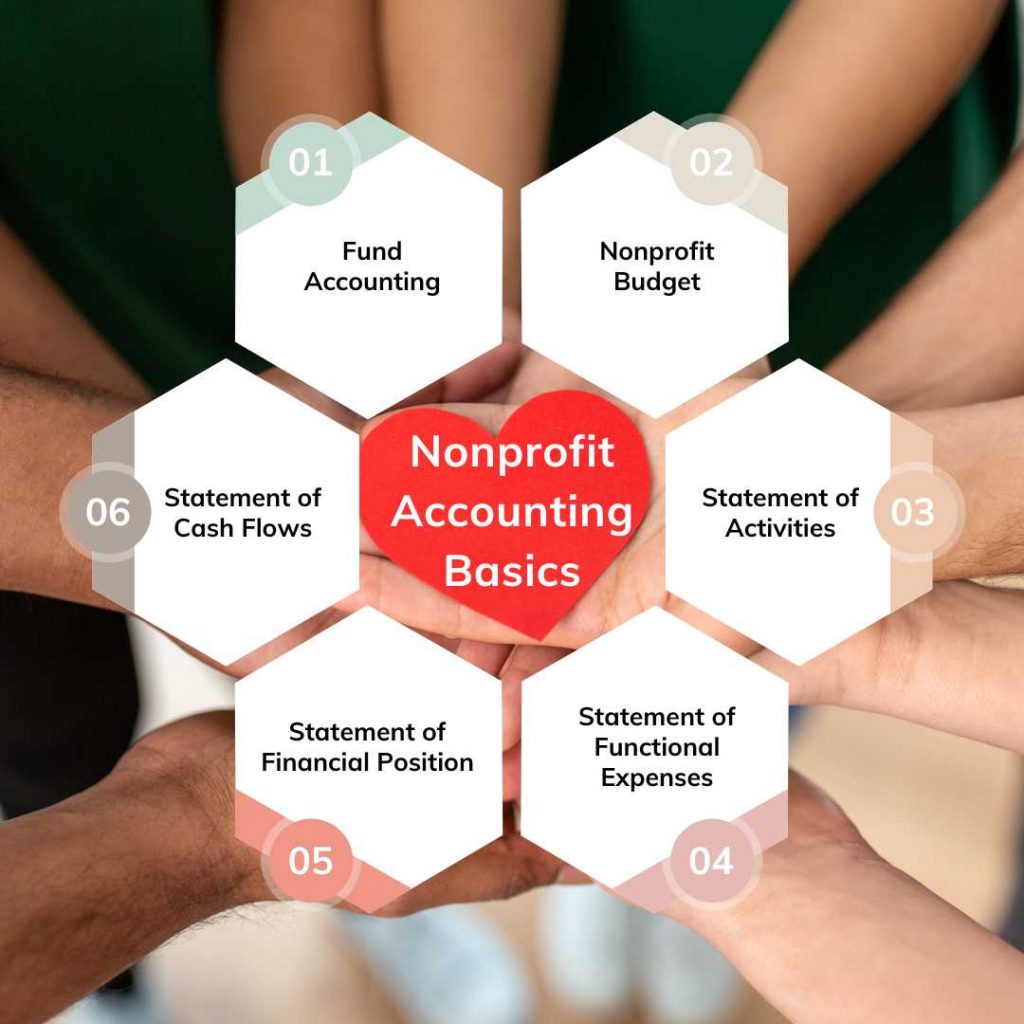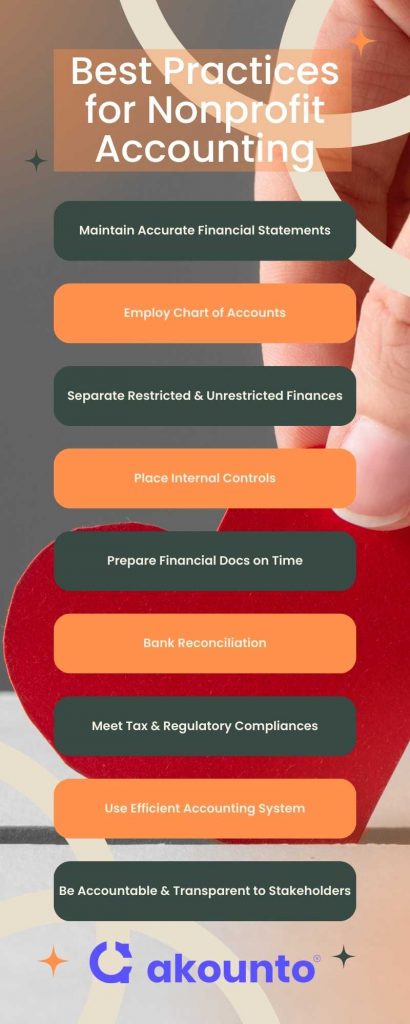Understanding Nonprofit Accounting
Nonprofit accounting is a unique set of accounting principles that aid in recording and analyzing the financial activities of a not-for-profit organization.
Nonprofit organizations work to add value to society instead of raising their financial position, which makes them different from for-profit businesses.
Nonprofits use the same accounting principles to record transactions, account for fixed assets, and manage accounts receivable and accounts payable, as do the for-profits. But the contents of the financial statements and the taxation rules differ.
Here are some nonprofit accounting basics that characterize the nonprofit version of accounting:
Fund Accounting
Fund accounting ensures that all the charity and donations made to any nonprofit organization can be spent only on the “agreed” terms and conditions.
Fund accounting ensures the investment is spent on the right programs known to the investors.
Types of Funds in Nonprofit Accounting
The funds in a nonprofit accounting organization are divided into three categories:
- Unrestricted funds are grants, donations, or other types of funds that do not come with donor-designated restrictions and can be used by organizations to stay operational. For example, unrestricted funds can be used for operating expenses like office rent.
- Restricted funds are subject to certain stipulations by the donor. The restrictions remain in place until the donation amount is completely utilized. For example, a donor donated $5,000 for scholarships to a nonprofit organization. So, the organization will have to use the $5,000 to fund scholarships regardless of the time since the donation came in.
- Temporarily restricted funds are the ones that are restricted for a certain amount of time and then become unrestricted.
Nonprofit Budget
A nonprofit’s budget is a document that estimates how much cash flow is required and also states the revenue generated.
Nonprofit accounting basics heavily rely on the budget to confirm future goals, plan an agenda, and allocate resources accordingly. The budget usually comes out annually.
You can calculate the expected revenue in two ways:
- Cut-off Method: Consider each revenue stream and multiply it by the probability of getting the funds. Let’s assume that a nonprofit has a 60% chance of receiving a grant of $5,000; then, you would multiply $5000 by 0.6 or 60%. The accounting team will then mention $3000 in the budget.
- Discount Method: Consider all the revenue streams as one, and then factor in the probability that you will receive it. For example, if you expect total revenue of $50,000 and have a 50% chance of achieving it, you would write $25000 in your budget.
Statement of Activities
The statement of activities of an organization is known as the revenue statement. The report depicts the organization’s earnings and spending over a certain period. A for-profit business uses the nonprofit counterpart of the income statement.
In place of the net income, nonprofits calculate the change in net assets, which depicts how much an organization has spent on its activities toward a certain mission.
Statement of Functional Expenses
A functional expense statement categorizes the organization’s expenses and spending and assigns a “function” to each item. The classification divides expenditures into three operational functions: program expenses, administrative expenses, and fundraising activity expenses.
Providing accurate data on the statement of operational expenditures also aids in the completion of your yearly Form 990, which requires expenses to be divided similarly.
A modification to the general practice in 2017 makes the firm obliged to declare the “nature” of the actions included in this report by your organization.
For example, what proportion of your postage requirements are for advertising the fundraisers and administrative costs such as building maintenance?
Statement of Financial Position
Nonprofit organizations have to prepare and submit a statement of financial position, listing all their financial activities and current position. The nonprofit version of the statement of financial position is a balance sheet, which for-profit companies use.
A statement of financial position differs from a balance sheet in one way: nonprofit organizations do not have an owner but shareholders, so they use net assets instead of equity.
The statement of financial position will feature three main components: assets, liabilities, and equity (net assets).
Assets = Liabilities + Net assets
The financial statements must be prepared in compliance with the rules mentioned in FASB (Financial Accounting Standards Board) and GAAP (Generally Accepted Accounting Principles).
Statement of Cash Flows
The cash flow statement for a nonprofit organization demonstrates how money and funds flow within and outside the organization. It lets you determine how much money is available to pay the bills and expenses at any time, just as in for-profit accounting.
Statement of cash flow deconstructs the organization’s operational, financing, and investment operations to demonstrate how cash flows. It breaks down for a nonprofit accounting team which time of the year or which business operations bring in more cash flow.
By analyzing this statement, a nonprofit can quickly discover how fundraising, in-kind donations, and advertising should be strategized for maximum revenue inflow.
Nonprofit accounting may be intimidating at times. However, if you understand how to read numerous accounting documents, it will be much easier to comprehend how your organization’s finances work and flow.
However, charity accounting is more than just gathering vital data. You must also learn to apply this knowledge to make sound accounting judgments.
Nonprofit Accounting: In-house or Remote Accounting
In-house accounting is the conventional accounting performed by physically available workers at the organization’s location.
Remote accounting firms hire remote individuals who use cloud computing software for profit accounting.
In-house and remote accounting both have their advantages and disadvantages. Here is everything summed up:
| Remote Accounting | In-House Accounting |
| The employees of remote accounting work remotely and communicate with the company virtually. | The employees of in-house accounting work on-site and communicate with the company in person. |
| Remote accounting individuals may have more experience because they work for different organizations remotely. | In-house accounting individuals may know more about the company that they work in than remote accounting individuals as they are closer to the action. |
| Remote accounting costs less as there is only a basic salary and no extra costs such as electricity. | In-house accounting can be expensive as it contains lots of expenses apart from the basic salary. |
| Remote accounting is scalable; you can hire or fire employees without spending extra. | In-house accounting is not easily scalable due to the requirement of additional resources. You may have to spend extra on training a new employee. |
| Best for small to medium businesses. | Best for large businesses that have more complexities. |
Legal Compliances for Nonprofit Accounting
Since not-for-profit organizations have a different structure and operational model than for-profit businesses, the nonprofit accounting methods must comply with various legal standards, which are as the following:
Section 501
Section 501 deals with charities, NGOs, and religious organizations that are not required to pay federal taxes to the IRS.
While the Internal Revenue Service and federal law may determine tax-exempt status, state law determines nonprofit status. As a result, before filing for tax-exempt status, you must establish nonprofit status in your state.
After registering as a nonprofit organization with the state where you are located, the next step is to apply for Section 501 tax-exempt status.
The IRS accepts three petitions for tax exemption:
Form 1023: Form 1023 must be submitted to request tax-exempt status under Internal Revenue Code section 501(c)(3). This form establishes that the organization satisfies the criteria for availing tax-exempt status as a charity or religious organization.
Form 1024-A: Form 1024-A is slightly different from Form 1023. Form 1024-A is used by organizations requesting tax-exempt status under section 501(c)(4), which includes social welfare organizations, as opposed to Form 1023, which is expressly for 501(c)(3) organizations.
Form 1024: Form 1024 is also required in the United States when applying for tax-exempt status under sections other than 501(c)(3) or 501(c)(4) of the IRS.
Social clubs, labor unions, business leagues, and other organizations will use Form 1024 when applying for tax-exempt status.
FASB 117
Financial Accounting Standards Board Statement No. 117 is an accounting standard for nonprofit organizations. It creates the structure for presenting financial information by providing principles for financial reporting and makes four financial documents necessary for a nonprofit:
- Statement of financial position
- Statement of cash flows
- Statement of activities
Form 990
Form 990 is the yearly taxation form that discloses the actual revenue, expenses, changes in net assets, and unrelated business activities. The nonprofit accounting staff must submit an annual tax Form 990 to the Internal Revenue Service to maintain their tax-exempt status.
A nonprofit pays federal taxes on unrelated business activities, regardless of which tax code applies to the organization. The Form 990 is essentially the IRS’s technique of determining whether or not your organization is fiscally honest and legal.
Income Statement and Other Data
All financial transactions, invoices, and bank account statements must be kept intact. These financial reports should be kept for 3-7 years as they may be required anytime during the mentioned duration.
Establishing a governance board ensures that the organization follows the rules and regulations. This board must overlook the organization’s activities and ensure that the best practices for nonprofit organizations are followed.
Basic Nonprofit Accounting Regulations

- Nonprofit accounting must follow federal and state laws that prevent discrimination based on color, nationality, race, religion, sex, age, or disabilities. NGOs must make their programs, services, fundraising events, and activities available to everyone.
- Nonprofit organizations that raise funds are subject to regulations governing charity solicitation. These laws force nonprofit organizations to register their financial statements with federal and state authorities, give donor disclosures, and follow guidelines controlling how funds are sought and restricted donations are utilized.
- Intellectual property rules such as trademarks, copyrights, and patent laws apply to nonprofit organizations.
- Nonprofit organizations must follow rules that regulate their capacity to engage in lobbyist and political activities.
Organizations participating in lobbying must register with the IRS and conform to specific reporting requirements. Those participating in political action must guarantee that their tax-exempt and nonprofit status is not jeopardized.
Any organization failing to meet legal compliance requirements may face penalties according to the law. Organizations must hire relevant attorneys and professionals to ensure no such incident occurs.
Cash or Accrual Accounting Method?
Cash accounting is basic and uncomplicated, making it an excellent alternative for small enterprises with simple transactions. Accrual accounting, on the other hand, is better suited to organizations with more complicated deals, such as ones that use credit sales or possess inventory.
Since it recognizes income and costs when cash arrives or goes out, cash accounting can accurately depict a company’s cash flow in the near term. However, accrual accounting gives a more realistic long-term view of a company’s financial condition and performance.
Which is Better and Why?
Accrual accounting is widely accepted as the ideal form of nonprofit accounting for the following reasons:
Accrual accounting gives a more accurate view of an organization’s financial health since it matches income and costs to the time frame in which they are incurred.
It enables NGOs to govern their cash flow more effectively by anticipating and planning for future needs.
Accrual accounting improves financial reporting to grantors, contributors, and stakeholders by providing a clearer picture of the company’s financial stability.
Best Practices for Nonprofit Accounting

A set of practices can help a nonprofit organization boost fundraising expenses, investment income, and performance and avoid unexpected hurdles.
- Nonprofits must keep accurate and up-to-date financial statements such as balance sheets, statements of financial position, and cash flow statements. It will assist the organization in tracking its financial results and making sound decisions.
- A chart of accounts is a standardized set of account numbering and names that aids in organizing and classifying financial activities. Nonprofits should employ a chart of accounts adapted to their unique needs, and all transactions should be properly classified and recorded.
- Nonprofits should separate their restricted and unrestricted money on the financial statements to guarantee that restricted monies are only used for their intended objectives. It can assist in avoiding the theft of cash and ensure that donor limitations are followed.
- Internal controls are rules and processes to prevent fraud and ensure the precision and authenticity of financial reports. Nonprofits should place internal controls suitable for their size and complexity so that their financial position always looks clear.
- Nonprofits must prepare financial documents on schedule and accurately, including yearly budgets, statements of earnings, and balance sheets. A third-party auditor or another accounting professional should evaluate these statements to confirm their correctness and conformity with GAAP.
- Bank reconciliation once a month can keep the history clean and accurate. The entries on the bank statement will match the internal records, making financial reporting easier and more efficient than ever.
- Nonprofits must meet all tax and regulatory obligations, including submitting yearly tax returns and preserving sufficient paperwork for all financial transactions. It can help the organization avoid fines and keep its tax-exempt status.
- Place an efficient accounting system for managing petty cash transactions. Keep track of the bank account transactions meant to serve the office’s petty expenses and ensure they are only spent on the authorized ones.
- Nonprofits should be accountable and transparent to their stakeholders, which include funders, members, and the general public. It may be accomplished by consistent accounting information, communication, and adherence to ethical and best practices standards.
Comprehend Tax Responsibilities
Below is a brief account of the tax obligations of a nonprofit organization, despite its tax-exempt status:
- The IRS requires charitable organizations to file Form 990, an annual information return that gives information about the organization’s operations, income statement, finances, and governance. The applicable version of Form 990 for a certain organization depends on its size, kind, and location of operation.
- Nonprofits may be excused from paying income taxes on property and real estate used for exempted purposes, yet they may still be required to pay property taxes on other forms of assets, such as automobiles or equipment.
- Employed nonprofits must pay employment taxes, which include taxes on Social Security and Medicare, state and federal unemployment taxes, and tax on earnings withholding.
- Nonprofits may be liable to various other taxes, like income tax, property tax, and sales taxes, which heavily depend on the state or location of operation.
- Maintaining proper records of the finances is inevitable for a nonprofit, in addition to preparing and submitting annual tax reports (like Form 990 for the US) and following all relevant tax rules and regulations.
Using Accounting Software
Cloud accounting software is housed on remote computers and accessed over the internet. It thus reduces manual effort, time, and the company’s resources by implementing an automated accounting system.
Nonprofit accounting is aided in the following ways by cloud-based accounting software:
- The nonprofit personnel can view their financial data anywhere, anytime. This universality of the workplace offers remote hiring and flexible working hours. The staff can also always access the most updated data with current facts.
- Cloud accounting software lets several people view and work on the same data simultaneously, improving cooperation and communication among charity employees. Effective communication can prevent organizational drag in so many forms, streamline tasks, and increase productivity.
- Cloud-based accounting systems include automated operations that can assist NGOs in saving time and reducing mistakes, such as tracking overhead expenses. Automatic bank feeds, for example, can eliminate the need for human data entry, and automated invoices and payment processing may speed up accounts paying and receiving.
- Digital platforms for accounting suppliers often employ stringent security measures to safeguard sensitive financial information. Virtual existence and cyber security keep the accounts’ data safe and protected.
- Cloud-based accounting systems may be readily scaled up or down to match changes in the size or activities of the organization. Furthermore, several cloud-based accounting software packages include variable price options, allowing NGOs to pay according to their non-profit accounting requirements.
Conclusion
Effective nonprofit accounting can align the internal and external processes and increase funding sources and the overall transparency of the organization. An automated accounting system can go a long way in managing accounts receivable, and accounts payable, calculating a change in net assets, and preparing financial statements such as the statement of financial position.
Visit our blogs for more insights into for-profit and nonprofit accounting.




